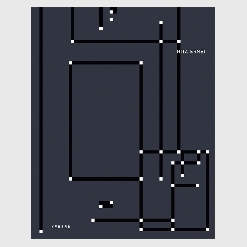The work of architect Ludwig Mies van der Rohe as inspiration for the work of artist Rita Ernst.
Preface by Wita Noack, Mies van der Rohe-Haus, Berlin
Over the last ten years the Swiss painter Rita Ernst has been working on an  image cycle that bears the title Projekt – Mies van der Rohe. In more than fifty images–which are presented in this catalog–the painter researches the visual logic of the floor plan shapes of various buildings by the architect Ludwig Mies van der Rohe. In its artistic substance the image cycle Projekt – Mies van der Rohe by Rita Ernst is unique, as diversity, depth, and experiment go hand-in-hand here.
image cycle that bears the title Projekt – Mies van der Rohe. In more than fifty images–which are presented in this catalog–the painter researches the visual logic of the floor plan shapes of various buildings by the architect Ludwig Mies van der Rohe. In its artistic substance the image cycle Projekt – Mies van der Rohe by Rita Ernst is unique, as diversity, depth, and experiment go hand-in-hand here.
In all veneration of the famous architect the painter nevertheless remains true to herself by devoting herself, in this image series exactly as in all her others, to her great life’s task: to the painterly research of visual ordering systems. These are, for example, basic geometric shapes such as circle, square, and rectangle, or graphic characters, ornaments from Tunisian tiles, layouts of gardens of paradise and old palaces on Sicily. Even in architectural photographs of the Landhaus Lemke she finds abstract forms, which she subjects to a painterly examination. On this topic, too, the present book contains in its image section a series of illustrations that bear the title Spazio.
However, it is the floor plan shapes of Mies’s works, both built and unbuilt, that exert a particular fascination over Rita Ernst, as they are constructed asymmetrically. The floor plans possess a complex logic. Their form is not easy to decipher, for all kinds of demands on a building (venustas, utilitas, firmitas) lead ultimately to abstract floor plan shapes.
As a painter Rita Ernst deals very freely with the shapes that she has explored and selected for her artistic work. Precisely through her painterly method of emphasis, displacement, and reassessment she arrives at visual results that contribute ultimately to a profound understanding of culture in the broadest sense. At the same time she celebrates on canvas everything that is ordered, that signifies beauty, and that makes sense.
[…]
